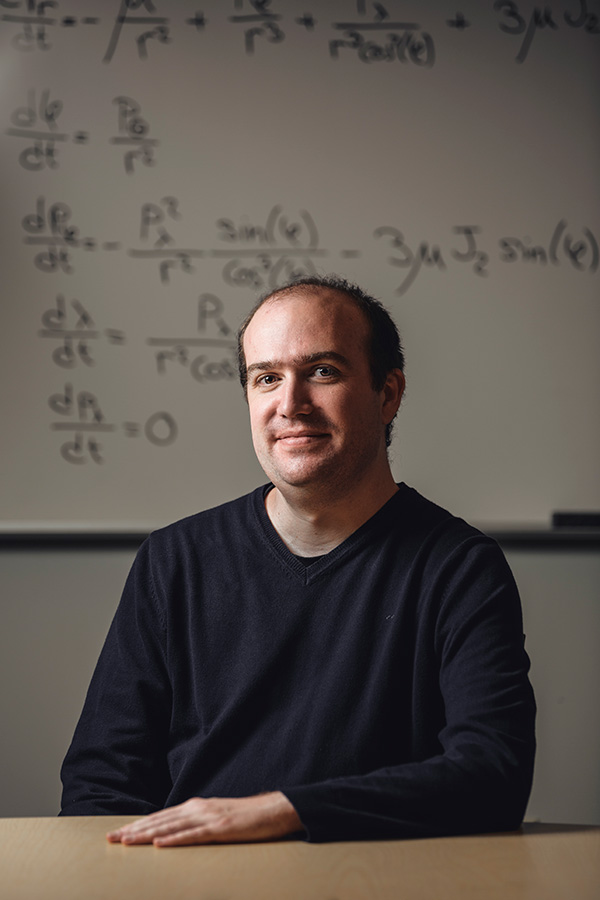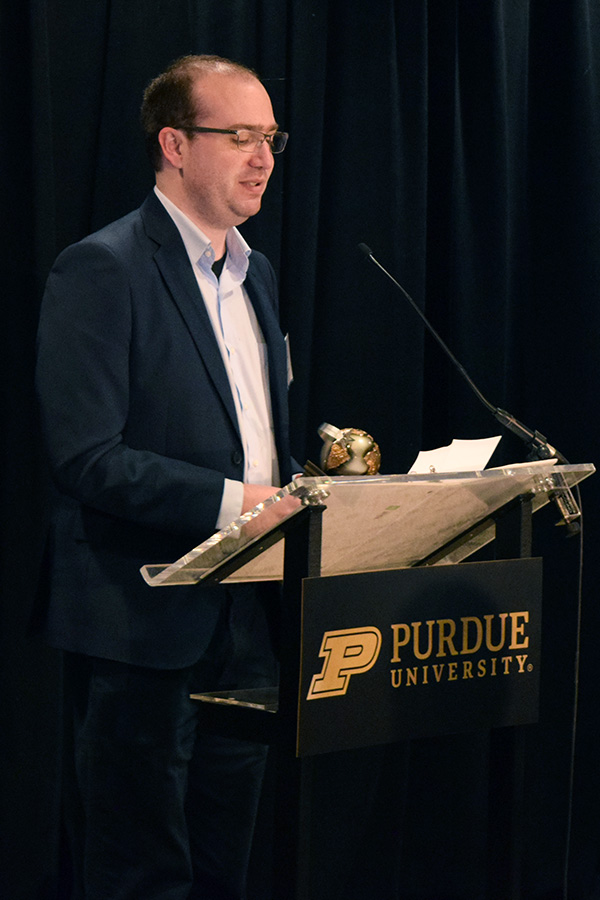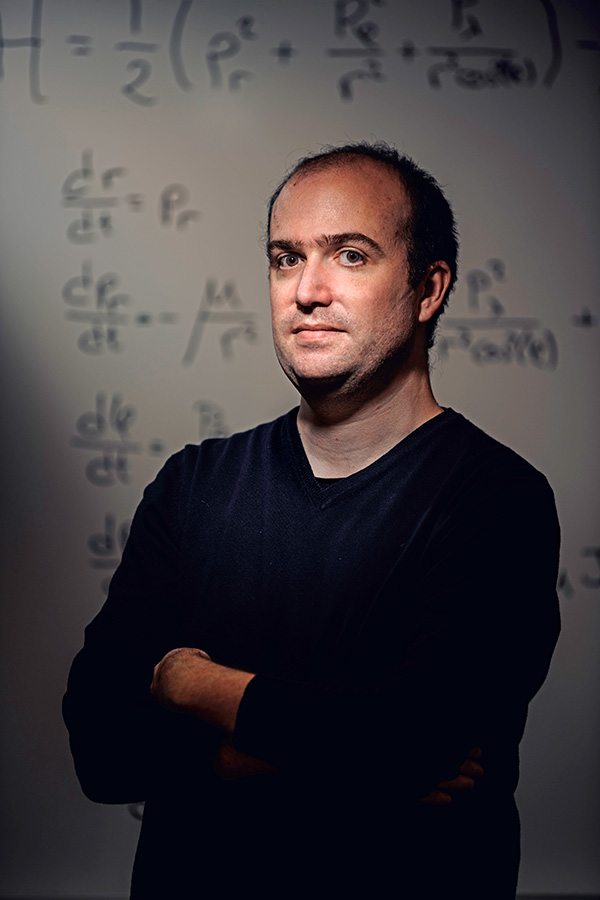AAE Faculty Profile: David Arnas, bringing chaos into order
Creating mathematical models for satellite management

Space has become critically congested, says Purdue AAE Assistant Professor David Arnas. As a researcher of satellite constellations and their orbits, he believes a turning point will soon dictate whether humans can continue to use space in our future. Arnas is developing mathematical models that would enable higher satellite densities and reduce the likelihood of collisions in Low Earth Orbit (LEO).
“Satellites do not care about national borders, they only care about gravitation,” he says. “Space is a common resource of humanity, just like water and air. Even if it seems very vast, it is still limited. It is our responsibility to ensure that future generations will also have fair access to it.”
Arnas believes his mathematical models will help organizations plan more efficient and precise satellite orbits. These can do more than just optimize propellant use: They can be a cornerstone of a future space traffic management system, and address the need of responsible and equitable use of space.
His work contributes to Purdue’s Cislunar Initiative, which is conducting a variety of research to enable better use of the space between the Earth and the Moon. It also serves his main passion, which is supporting safe space travel through space traffic management.
The “Wild West” problem
The need to precisely track and predict orbits of satellites and debris will continue as public space exploration and private commercial interests branch out into cislunar space.
“With the amount of satellite launches performed each month, the probability of collision is getting higher and higher. The density of objects in Low Earth Orbit has increased dramatically, from around 1,000 satellites 10 years ago to 5,500 today. In the next 10 years, we are expecting to have more than 100,000,” he says.
Managing that many satellites with roughly the same number of control centers has been extremely challenging during unexpected events, such as the dodging the debris clouds caused by recent Chinese and Russian satellite collisions.

His research is demonstrating ways in which thousands of satellite orbits can be designed in a tighter range by giving each spacecraft its own “slot” separated from others. This system would also allow for faster response in the event of a solar storm or other major event.
Analysis without an analytical solution
A simple method to prevent satellite shells from overlapping is to separate them by altitude, such that the oscillations of the orbits in one shell never enters the altitude range of another, Arnas says. But this approach doesn’t allow for much density.
“Even circular orbits can have fluctuations of more than 12 kilometers in altitude, which consumes a large amount of the space available,” he says. “If you want to bring this distance down to less than 1 kilometer, you need accurate analytical models that are able to predict the maximum boundaries that orbits may experience under orbital perturbations.”
The biggest issue is that satellite dynamics don’t have an analytical solution.
“You can only have approximations, numerical or analytical, and the problem gets worse when you want to study what happens in a large population of satellites,” Arnas says.
Another factor that complicates these is that Earth’s gravitational pull varies throughout an orbit, depending on the density of what’s below. “Earth’s gravitational field is less than ideal. Think of it not as a sphere or a spheroid, but more like a big potato,” Arnas says.
Calculating these orbits numerically and at scale is not impossible, but it does take a lot of computing power and time. Computing time is not an available luxury in an emergency.
Arnas’ methods leverage his mathematical expertise to produce scalable mathematical operations. They open the possibility for obtaining optimal satellite distribution in a large space system, plus estimating both orbital capacity and the long-term evolution of that system.
“If we are able to convince everyone to launch their missions following these optimal distributions, we could assure that first, satellites are never going to produce conjunctions between them. This increases safety and reduces the fuel required to maintain missions,” Arnas says. “Second, there will be more positions available, which ensures sustainability and fair access to future missions. And third, if an accident happens up there, these mathematical structures enable a quick and safe procedure to reposition satellites that could be in danger.”
The heart of a mathematician, the heart of an engineer

Arnas’ motivation for making space accessible started early in his career, where he noticed unsettling trends in more than just the likelihood of satellite collisions. He saw what looked like deliberate attempts by satellite operators to push out their competition.
While at the European Space Agency conducting his doctoral research for Universidad de Zaragoza, he saw satellite missions that appeared to be changing their orbits to block others who were vying for that space. Arnas noticed more examples of this when he began working as an assistant professor at Zaragoza, collaborating with MIT on satellite constellations and space traffic management.
“Of course, there is always the doubt: Are they doing these maneuvers to improve the performance of their system, or because they want to prevent competitors from launching or operating their satellites?” Arnas says. “Due to the lack of public information available, it is not always possible to know exactly which the reason is, but just the fact that they have that power is disturbing.”
Creating structure from a loosely regulated environment is a deep source of meaning for him — and in a large satellite system, creating order comes with many benefits.
“If part of my heart is the heart of an engineer, and the other part is the heart of a mathematician, both of them are pointing in the same direction: From an engineering point of view, you want to optimize systems, and right now what we are doing is optimizing the profits of specific companies and agencies,” Arnas says.
“From a mathematical perspective, it’s a matter of scale, order, and probability. Even if the probability of collision is very small, it is just a matter of time that a collision or any other unexpected event, such as a big solar storm, will happen.”
When an event like this happens, Arnas says, we must be prepared to coordinate how all of those satellites should react — or face a possible chain reaction of collisions if we can’t. Making those maneuvering decisions in the moment will be nearly impossible without a plan.
Creating order from the chaos, he says, is the only way future generations will have access to space.
